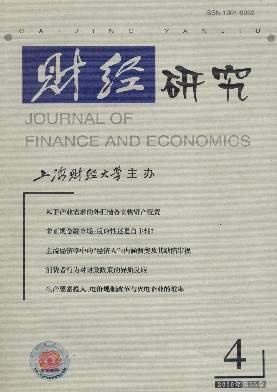外汇干预与就业、宏观经济增长研究——以1994—2007年中国外汇干预实证研究为例
财经研究 2009 年 第 35 卷第 04 期, 页码:26 - 38
摘要
参考文献
摘要
文章通过构建理论模型对外汇干预与就业、宏观经济增长之间的互动关系进行了研究,认为中央银行应能从外汇干预中获得正收益,同时外汇干预能有效降低就业与经济增长过程中大幅波动的可能性。在理论模型的基础上,文章对1994—2007年间中国外汇干预政策实施效果进行了实证研究,主要结论为与理论模型基本一致:市场化的人民币外汇干预会导致央行正向的干预收益,同时降低就业与经济增长的波动性。对于目前受到国际次贷危机影响的中国经济来说,采取更为灵活的外汇干预政策应是合理的政策选择。
[1]陈浪南,黄洵.联合外汇干预的实证研究[J].经济研究,2004,(5):58-66.
[2]华民.冲破马尔萨斯制约——对世界经济发展的再认识[J].复旦学报,2005,(3):1-13.
[3]陆前进.货币危机的投机冲击和远期外汇市场干预[J].国际金融研究,2001,(4):29-33.
[4]宋文兵.外汇市场干预的理论分析与国际比较[J].世界经济,1998,(6):34-39.
[5]邢毓静.必然的选择——全球化条件下外汇市场干预与货币政策[J].国际贸易,1999,(7):38-41.
[6]原雪梅.外汇市场干预政策效应分析[J].国际金融研究,1998,(10):20-24.
[7]朱涛,冯强,农淑贞.外汇干预中预期作用的研究[J].东南大学学报,1999,(3):46-49.
[8]曾振宇.非对称管制下的外汇市场干预:绩效与缺陷[J].世界经济与政治论坛,2003,(4):42-46.
[9]Cukierman A,Meltzer A H.Atheory of ambiguity,credibility,and inflation under dis-crefion and asymmetric information[J].Econometrica,1986,54:1099-1128.
[10]Dominguez K M,Frankel J A.Does foreign exchange intervention:Recent experience,1985-1988[A].Branson W H.International policy coordination and exchange rate fluc-tuation[C].The University of Chicago Press,1990:197-237.
[11]Dominguez K M.The market microstructure of central bankintervention[R].WorkingPaper,1999.
[12]Krugman P R.Target zones and exchange rate dynamics[J].The Quarterly Journal ofEconomics,1991,106(3):669-682.
[13]Obstfeld M.The effectiveness of foreign exchange intervention:Recent experience,1985-1988[A].Branson W H.International policy coordination and exchange rate fluc-tuation[C].The University of Chicago Press,1990:197-237.
[14]Radiger Dornbush.Expectation and exchange rate dynamics[J].Journal of Political E-conomics,1976,84(6):1161-1177.
[15]Schwartz A.The rise and fall of foreign exchange market intervention[R].NBERWorking Paper,2000,No.7751.
[16]Stein J.Cheap Talk and the FED:Atheory of i mprecise policy announcements[J].A-merican Economic Review,1990,79:32-42.
[17]Taylor M.The economics of exchange rates[J].Journal of Economic Literature,1995,33:13-47.
[18]Vitale P.Sterilized central bankinterventionin the foreign exchange market[J].Jour-nal of International Economics,1999,49:245-267.
[2]华民.冲破马尔萨斯制约——对世界经济发展的再认识[J].复旦学报,2005,(3):1-13.
[3]陆前进.货币危机的投机冲击和远期外汇市场干预[J].国际金融研究,2001,(4):29-33.
[4]宋文兵.外汇市场干预的理论分析与国际比较[J].世界经济,1998,(6):34-39.
[5]邢毓静.必然的选择——全球化条件下外汇市场干预与货币政策[J].国际贸易,1999,(7):38-41.
[6]原雪梅.外汇市场干预政策效应分析[J].国际金融研究,1998,(10):20-24.
[7]朱涛,冯强,农淑贞.外汇干预中预期作用的研究[J].东南大学学报,1999,(3):46-49.
[8]曾振宇.非对称管制下的外汇市场干预:绩效与缺陷[J].世界经济与政治论坛,2003,(4):42-46.
[9]Cukierman A,Meltzer A H.Atheory of ambiguity,credibility,and inflation under dis-crefion and asymmetric information[J].Econometrica,1986,54:1099-1128.
[10]Dominguez K M,Frankel J A.Does foreign exchange intervention:Recent experience,1985-1988[A].Branson W H.International policy coordination and exchange rate fluc-tuation[C].The University of Chicago Press,1990:197-237.
[11]Dominguez K M.The market microstructure of central bankintervention[R].WorkingPaper,1999.
[12]Krugman P R.Target zones and exchange rate dynamics[J].The Quarterly Journal ofEconomics,1991,106(3):669-682.
[13]Obstfeld M.The effectiveness of foreign exchange intervention:Recent experience,1985-1988[A].Branson W H.International policy coordination and exchange rate fluc-tuation[C].The University of Chicago Press,1990:197-237.
[14]Radiger Dornbush.Expectation and exchange rate dynamics[J].Journal of Political E-conomics,1976,84(6):1161-1177.
[15]Schwartz A.The rise and fall of foreign exchange market intervention[R].NBERWorking Paper,2000,No.7751.
[16]Stein J.Cheap Talk and the FED:Atheory of i mprecise policy announcements[J].A-merican Economic Review,1990,79:32-42.
[17]Taylor M.The economics of exchange rates[J].Journal of Economic Literature,1995,33:13-47.
[18]Vitale P.Sterilized central bankinterventionin the foreign exchange market[J].Jour-nal of International Economics,1999,49:245-267.
引用本文
陆志明, 程实. 外汇干预与就业、宏观经济增长研究——以1994—2007年中国外汇干预实证研究为例[J]. 财经研究, 2009, 35(4): 26–38.
导出参考文献,格式为:





 6067
6067  3802
3802

